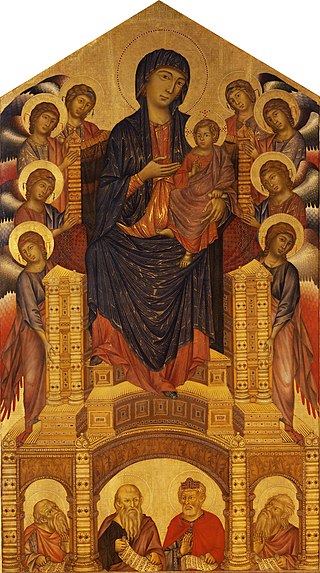
Giovanni Cimabue, c. 1240 – 1302, was an Italian painter and designer of mosaics from Florence. He was also known as Cenni di Pepo or Cenni di Pepi.
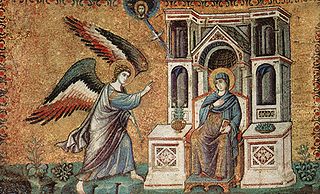
Pietro Cavallini was an Italian painter and mosaic designer working during the late Middle Ages.

The Basilica of Saint Francis of Assisi is the mother church of the Roman Catholic Order of Friars Minor Conventual in Assisi, a town in the Umbria region in central Italy, where Saint Francis was born and died. It is a papal minor basilica and one of the most important places of Christian pilgrimage in Italy. With its accompanying friary, Sacro Convento, the basilica is a distinctive landmark to those approaching Assisi. It has been a UNESCO World Heritage Site since 2000.

Giunta Pisano was an Italian painter. He is the earliest Italian painter whose name is found inscribed on an extant work. He is best known for his crucifixes.

The Basilica of Saint Mary of the Angels is a papal minor basilica situated in the plain at the foot of the hill of Assisi, Italy, in the frazione of Santa Maria degli Angeli.

The San Damiano Cross is the large Romanesque rood cross before which St. Francis of Assisi was praying when he is said to have received the commission from the Lord to rebuild the Church. It now hangs in the Basilica of Saint Clare in Assisi, Italy, with a replica in its original position in the church of San Damiano nearby. Franciscans cherish this cross as the symbol of their mission from God.

The Master of Saint Francis was an anonymous Italian painter, perhaps of Pisan origin though probably trained in Umbria, working between 1250–1280. His work embodies an important aspect of the Italo-Byzantine style resulting from contact between Italian and Byzantine art of this period.

Florentine painting or the Florentine school refers to artists in, from, or influenced by the naturalistic style developed in Florence in the 14th century, largely through the efforts of Giotto di Bondone, and in the 15th century the leading school of Western painting. Some of the best known painters of the earlier Florentine School are Fra Angelico, Botticelli, Filippo Lippi, the Ghirlandaio family, Masolino, and Masaccio.

Italian Gothic architecture (also called temperate Gothic architecture, has characteristics that distinguish it considerably from those of the place of origin of Gothic architecture, France, and from other European countries in which this language has spread.

The Crucifix of Pisa is a painting of the crucifixion painted on wood panel, dating to sometime around 1230 and currently in the Museo nazionale di San Matteo, Pisa, Italy. Its anonymous author is referred to as the Byzantine Master of the Crucifix of Pisa. He was an Italian painter active in Pisa in the first half of the thirteenth century. The painting is significant in the history of Italian painting for its iconography of the patient, suffering Christ on the cross; although then new, it quickly replaced the older style, depicting Christ triumphant and free from pain, with open eyes and a regal bearing free from sorrow.
The decade of the 1280s in art involved some significant events.

The Isaac Master was an Italian Gothic painter active in the decoration of the Basilica of San Francesco d'Assisi in Assisi at the end of the thirteenth century. Master's name is derived from a fresco painting of the death of Isaac for which he is known, the fresco is located in the Upper Church of St Francis at Assisi, depicting Isaac blessing Jacob and Esau.

Giotto di Bondone, known mononymously as Giotto, was an Italian painter and architect from Florence during the Late Middle Ages. He worked during the Gothic and Proto-Renaissance period. Giotto's contemporary, the banker and chronicler Giovanni Villani, wrote that Giotto was "the most sovereign master of painting in his time, who drew all his figures and their postures according to nature" and of his publicly recognized "talent and excellence". Giorgio Vasari described Giotto as making a decisive break from the prevalent Byzantine style and as initiating "the great art of painting as we know it today, introducing the technique of drawing accurately from life, which had been neglected for more than two hundred years".
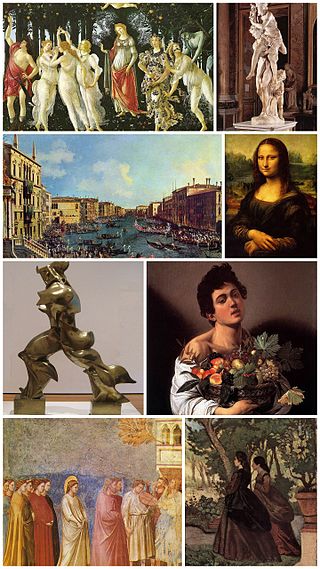
Duecento or Dugento is the Italian word for the Italian culture of the 13th century - that is to say 1200 to 1299. During this period the first shoots of the Italian Renaissance appeared, in literature and art, to be developed in the following trecento period.
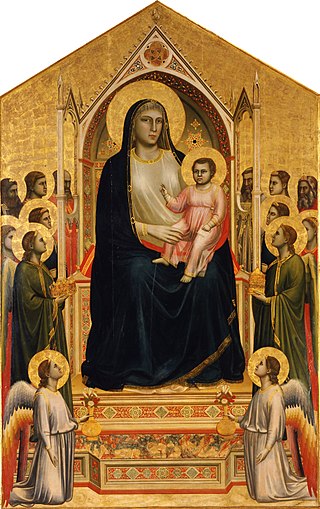
Madonna Enthroned, also known as the Ognissanti Madonna or Madonna Ognissanti, is a painting in tempera on wood panel by the Italian late medieval artist Giotto di Bondone, now in the Uffizi Gallery of Florence, Italy.

Saint Francis Receiving the Stigmata is a panel painting in tempera by the Italian artist Giotto, painted around 1295–1300 for the Church of Saint Francis in Pisa and it is now in the Musée du Louvre in Paris. It shows an episode from the life of Saint Francis of Assisi, and is 314 cm high by 162 cm wide. It is signed OPUS IOCTI FLORENTINI.
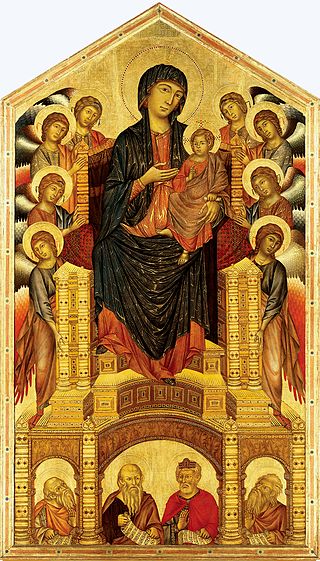
The Santa Trinita Maestà is a panel painting by the Italian medieval artist Cimabue, dating to c. 1288-1292. Originally painted for the church of Santa Trinita, Florence, where it remained until 1471, it is now in the Uffizi Gallery of Florence, Italy. It represents the Madonna enthroned with the Baby Jesus and surrounded by eight angels and, below, four half portraits of prophets.

The Crucifix by Cimabue at Santa Croce is a very large wooden crucifix, painted in distemper, attributed to the Florentine painter and mosaicist Cimabue, one of two large crucifixes attributed to him. The work was commissioned by the Franciscan friars of Santa Croce and is built from a complex arrangement of five main and eight ancillary timber boards. It is one of the first Italian artworks to break from the late medieval Byzantine style and is renowned for its technical innovations and humanistic iconography.

The Crucifix by Cimabue at Arezzo is a large wooden crucifix painted in distemper, with gold leaf, by the Florentine painter and mosaicist Cimabue, dated to c. 1267–71. It is the earliest of two large crucifixes attributed to him. It shows a painted representation of the near dead body of Christ on the cross, with Mary, mother of Jesus and John the Evangelist at either end of the cross beams.

Italo-Byzantine is a style term in art history, mostly used for medieval paintings produced in Italy under heavy influence from Byzantine art. It initially covers religious paintings copying or imitating the standard Byzantine icon types, but painted by artists without a training in Byzantine techniques. These are versions of Byzantine icons, most of the Madonna and Child, but also of other subjects; essentially they introduced the relatively small portable painting with a frame to Western Europe. Very often they are on a gold ground. It was the dominant style in Italian painting until the end of the 13th century, when Cimabue and Giotto began to take Italian, or at least Florentine, painting into new territory. But the style continued until the 15th century and beyond in some areas and contexts.






















